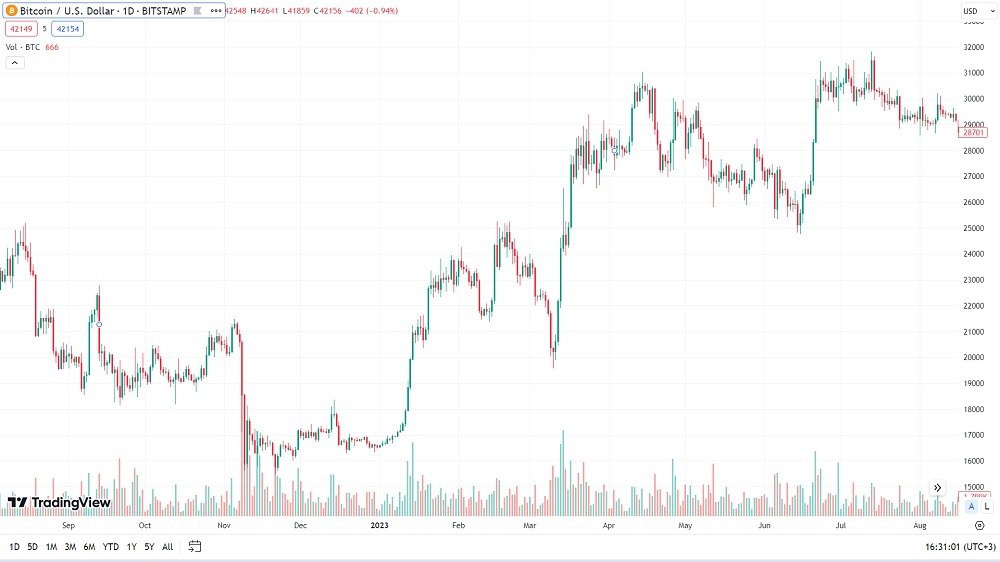
The terms "bulls" and "bears" are used in the context of the cryptocurrency market to refer to two opposite directions of price movement.
"Bulls” are investors who expect the price of a cryptocurrency to rise and buy it in the hope of making a profit.
"Bears" are investors who expect cryptocurrency prices to fall and sell them in the hope of making a profit.
Bull and bear traps are market conditions when cryptocurrency prices begin moving in a certain direction, luring in a sizeable number of investors, only to suddenly reverse in the opposite direction, leading to significant losses for many investors.
In this article, we explain what bull and bear traps are in the cryptocurrency market, how to avoid them, and how to make money from them.
What is a Bear Trap?
Bears in the trading of some assets, including cryptocurrencies, are called sellers who play the downside. The concept is purely conditional, as any trader will both sell and buy, depending on the situation.
A bear trap is a figure on the price chart that occurs after downward movement. The figure indicates that when a local minimum is reached, the minimum is broken. At this moment, the bears receive a signal to sell. However, this is only fiction. The price turns around and immediately begins to rise.
The formation of bear traps is usually accompanied by a strong support level. Once it reaches and breaks, there is a signal to sell. However, this is a trap. After some time, the price returns to the support level, which has now become resistant, breaking it from below, and growth begins.
For example, Bitcoin grew steadily in January 2023. In the early days of February, BTC was corrected to the $21,350-$21,450 area. This formed a resistance level. After that, BTC started to grow again and exceeded $25,000 on the 20th of February. The correction followed. The support level was to be a mark in the neighborhood of $21,350-$21,450.

However, on the 9th, Bitcoin fell lower, announcing that the bears were in control and that further declines were to be expected, but on the 11th, Bitcoin began to rise again, and on the 12th, it broke through the $21,450 level. Therefore, the bears were trapped and had to liquidate their positions.
What is a Bull Trap?
This is a chart phenomenon that is the opposite of that of a bear trap. The victims are not sellers (bears) but buyers (bulls). The bull trap itself occurs after the cryptocurrency price increases.
It typically forms after the resistance level is reached and broken. This is the moment at which they buy. Many bulls have taken advantage of this and have started buying cryptocurrencies. However, the trend immediately changes; the price returns to the level and continues to fall. In this case, the bulls were lost.
Consider a real-world example. In the first 20 days of 2023, ETH rose to $1,671. After that, there was a lull in the form of sideways movement. This continued until the ether closed above $1,671 on Wednesdays on February 15.
However, subsequent events showed that this was only a trap for the bulls. There was no impetus for growth. After trading above this level for six days, the ether fell below $1,671 on the 21st and began to fall. Short-term bulls must close their positions.
How to Find a Trap and Not Fall Into It
When we discuss about 100% probability in the context of crypto, there is no such thing. The formation of both bear and bull traps subsequently occurred. Once the price goes above or below resistance or support, we cannot predict anything.
We cannot see in advance what will happen to the price; all we get at once is a buy signal in the case of a bull trap, or a sell signal in the case of a bear trap. However, several techniques can reduce the likelihood of loss.
- The first, and probably the most effective, is to trade in larger time frames: daily, weekly, monthly, etc.. The shorter the trading period is, the more pitfalls they encounter. If we discuss investors who use fundamental analysis the most, their risks are the lowest.
- The second thing you can do is to look at the volumes. If the level is broken in a small volume, it is a reason to believe that a trap is forming. However, if the level is broken in large volumes, the trend is likely to continue.
- You can also use various technical methods: oscillators, Fibonacci levels, and candlestick analysis. All of these can provide specific signals to avoid getting into trouble. This is especially important for cryptocurrencies, because of their high volatility. If you short Bitcoin and get caught in a bear trap, you risk losing your position.
It is important to remember that there is no all-in-one solution, except for studying market patterns and adapting to them with your trading style.
Bottom Line
Bear and bull traps are patterns in the cryptocurrency market. Although it is impossible to identify them in advance with a 100% probability, a cautious trading strategy and informed decisions will allow us to avoid losses in most market situations.
If you are scaling ultra-frequent trading, the traps are simply not taken into account because they take too long to form. You cannot afford to wait for that long. While the trap is forming, the scalper can make profits several times on intraday price movements. The investor, the long trader, will also ignore traps because they are just noise. An investor takes as long as it takes and comes out on the winning side.
Inexperienced traders who are just getting to know the crypto markets are more likely to fall into the trap. Medium-term traders also fall into this category. Again, the question is not whether you will fall into a bull or bear trap, but how effective your risk management system will be and how much you will lose.




